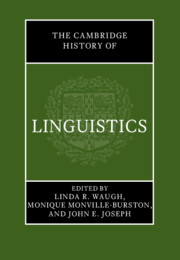Book contents
- The Cambridge History of Linguistics
- The Cambridge History of Linguistics
- Copyright page
- Dedication
- Contents
- Figures
- Tables
- Contributors
- Preface
- Acknowledgments
- Abbreviations, Acronyms, Special Symbols, and Other Conventions
- Introduction
- Part I Ancient, Classical, and Medieval Periods
- Part II Renaissance to Late Nineteenth Century
- Part III Late Nineteenth-through Twentieth-Century Linguistics
- Introduction to Part III Late Nineteenth-through Twentieth-Century Linguistics: Synopsis of Major Trends
- Part IIIA Late Nineteenth Century through the 1950s: Synchrony, Autonomy, and Structuralism
- Part IIIB 1960–2000: Formalism, Cognitivism, Language Use and Function, Interdisciplinarity
- References
- Index
Introduction to Part III - Late Nineteenth-through Twentieth-Century Linguistics: Synopsis of Major Trends
from Part III - Late Nineteenth-through Twentieth-Century Linguistics
Published online by Cambridge University Press: 20 July 2023
- The Cambridge History of Linguistics
- The Cambridge History of Linguistics
- Copyright page
- Dedication
- Contents
- Figures
- Tables
- Contributors
- Preface
- Acknowledgments
- Abbreviations, Acronyms, Special Symbols, and Other Conventions
- Introduction
- Part I Ancient, Classical, and Medieval Periods
- Part II Renaissance to Late Nineteenth Century
- Part III Late Nineteenth-through Twentieth-Century Linguistics
- Introduction to Part III Late Nineteenth-through Twentieth-Century Linguistics: Synopsis of Major Trends
- Part IIIA Late Nineteenth Century through the 1950s: Synchrony, Autonomy, and Structuralism
- Part IIIB 1960–2000: Formalism, Cognitivism, Language Use and Function, Interdisciplinarity
- References
- Index
Summary
This introduction is a synopsis of the major trends in linguistics discussed in Part III (seventeen chapters).
Part IIIA (late nineteenth century -- 1960s) describes the decline of comparative studies, the rise and culmination of structuralist and descriptive synchronic linguistics, and the different currents in Europe and North America (four chapters).
In Part IIIB (1960s-2000, ‘recent history,'a time of considerable growth in linguistic scholarship, thirteen chapters), the following topics are considered:
- the rise, development and impact of formal linguistics (i.e., generative approaches to syntax, semantics and phonology, and alternatives) as well as formal and non-formal cognitive approaches;
- the turn to language use and function: new modes/tools of linguistic inquiry (methods, corpora and lexicography, technology); functionalist reactions to formalism (e.g., pragmatics, American functionalism, systemic functional linguistics); language as a communicative spoken activity (conversation analysis, discourse analysis, ethnography of communication, critical approaches to language use);
- new interdisciplinary subfields: sociolinguistics (variational sociolinguistics, interactional sociolinguistics, language policy and planning), anthropological linguistics, psycholinguistics;
- historical linguistics (language change, grammaticalization), contact linguistics, pidgins and creoles, approaches to universal-typological linguistics;
- applied linguistics (language teaching/learning, interdisciplinarity).
The conclusion discusses the editors’ sense of the direction of theoretical developments in linguistics since the 1960s: the general movement towards contextualization.
Keywords
- Type
- Chapter
- Information
- The Cambridge History of Linguistics , pp. 363 - 440Publisher: Cambridge University PressPrint publication year: 2023

